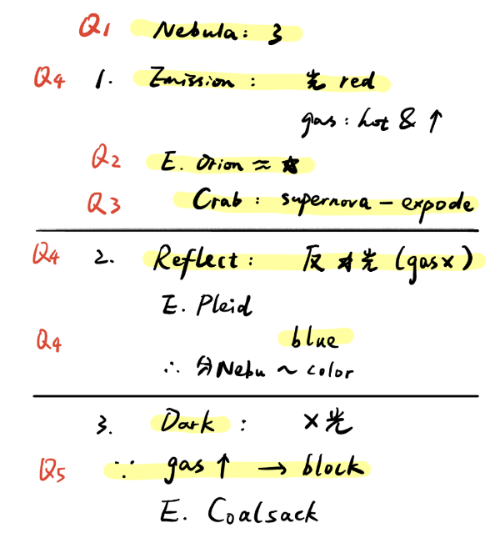本文来自新航道重庆学校托福组景蔚超(Sukey)老师。
很多托福听力考生总感觉听力材料太长,什么都记才能安心,然而即使从头记到尾,做题的时候也找不到答案,妥妥“大冤种”一枚。那么,一篇有效的笔记需要包括哪些要素?首先,需要包含文章主题与主观点;其次,需要有分层结构以及例子细节,但重复的内容不用记;最后,关键词记录需要准确和全面,理解优先于记笔记,常见词可用简写符号替代。

接下来,跟着Sukey老师一起,看看托福听力高频话题Nebula这篇讲座该如何做出有效的笔记。
u 讲座文本
Listen to part of a lecture in an astronomy class.
Okay. Let's get started. Last time we talked about the types of stars that make up the galaxy and how they evolved. Today let’s talk about nebula. The singular nebula, plural nebulae. Nebulae are clouds of gas and that occur here end there out in the galaxy and interstellar space. I am gonna talk about three kinds of nebulae (主旨) and will start with Emission Nebulae. (第一种星云)They are called Emission Nebulae because they emit their own light.(解释说明)The cloud of gas and dust in the Emission Nebula is hot and glowing. (特点)Um, two famous examples of Emission Nebulae are the Orion Nebula and the Crab Nebula. (列举2个例子)The Orion Nebula looks like a star to the naked eye. (例1特点)If you know what the constellation Orion looks like, it's the middle star of Orion sword. Even with a small telescope, you can see that if looks a little fuzzy, and with really good telescopes we can tell them that it’s a cloud of glowing gases. Inside that cloud there are hundreds of bright young stars and new stars being formed. Those young stars keep the gas in the nebula hot enough to glow. And the Crab Nebula is in the constellation Taurus. It's not an area of star formation. It's the remains of a supernova, an exploding star 1,000 years ago. (例2特点)The supernova was so bright that it was visible in the daytime for 23 days. The gas that exploded in the space is still glowing and is still expanding outwards from the explosion site. And we see it now as the Crab Nebula. So star formation is not necessarily the source of the right in Emission Nebulae. (段落总结:发射星云中光的来源不一定是行星形成)
Reflection Nebulae also give off light, but it’s not their own.(第二种星云)Reflection Nebulae reflect light from the stars around them.(解释说明)A good example of this is in the Pleiades constellation where the stars are surrounded by clouds of gas.(例子) The light you see from these clouds of gas is light reflected from the bright stars they are surrounding rather than light which originates in the gas clouds themselves. And Emission Nebula like the Orion or Crab nebula tends to give up red light. But you find that reflection nebulae tend to be blue because the stars that are hot enough and bright enough to illuminate such nebulae are usually blue in color. (对比发射星云和反光星云)Remember that from last time, the blue stars of the really hot ones. But it’s the stars that are hot. not the gas in the nebula. That's one difference. In the reflection nebula the gas doesn't get hot enough to glow on its own, while in emission nebulae it's the gas that glows. So a crude first cut in distinguishing nebulae is simply on the basis of color. (段落总结:区分星云的初步标准是依据颜色)
Okay. The third type of nebulae I am going to talk about are Dark Nebulae.(第三种星云)And they don't give off light at all. (解释说明)That’s because the dust and gas within them is so concentrated it blocks the light of the stars that are beyond them from view. (不发光的原因)A good example of the Dark Nebula would be the cold fat nebula. The cold fat nebula is in the Southern Cross constellation. (举例)It's the most visible Dark Nebula. It can be seen with the naked eye. Not from here. You can see from here so far north. You gotta be closer to the equator, or south of the equator. So when you look at Dark Nebula, what you see is what looks like a dark hole in the region where you have a very bright background. It's an absence of brightness where you would expect to see bright material, for example a region where you have a high density of stars or a bright emission nebula, and suddenly it looks like there’s a dark gap or a hole in it. That’s the dark nebula.

u 笔记
说明:Q6重听题在于理解,不包含在此笔记中。Q1-Q5对应题目,黄色高亮对应题目答案。 E. 代表“for example”; ∵代表“因为”; ∴代表“所以” ;⭐代表“star”
u 题目
1. What does the professor mainly discuss?
A Ways that stars become nebulae
B Reasons that nebulae appear to give off blue light
C Difference between nebulae and stars
D A basis for classifying types of nebulae
2. What point does the professor make about Orion’s sword?
A It points toward a nebula in the constellation Taurus.
B It contains a nebula that looks like a star to the naked eye.
C It contains stars whose light is a reflection of other nearby stars.
D It contains two stars that are remnants of a supernova.
3. What does the professor say about the origin of the Crab Nebula?
A It was formed when interstellar gas clouds combined.
B It was created by an exploding star.
C It did not emit when it was first formed.
D It was formed in the same way as many reflection nebulae.
4. Based on the lecture, which answer choices describe Emission Nebulae and which describe Reflection Nebulae?
Click on an answer choice. Then drag it into the space where it belongs. One of the answer choices will not be used.
Emission Nebulae
Reflection Nebulae
Answer choices
A. They give off red light.
B. They give off blue light.
C. They can only be seen from locations near the equator.
D. They do not contain glowing gas.
1. What is a typical characteristic of Dark Nebulae?
A They are obscured from view by nearby stars.
B They are located in parts of the sky that do not contain bright stars.
C The dust and gas they contain are too dense to let light through.
D They are too hot to emit radiation in the visible range.
u 正确答案 (不包含Q6重听题)
1. D 2. B 3. B 5. C
4.Emission Nebulae A
Reflection Nebulae B D
以上就是本期有关托福听力有效笔记的讲解,大家都GET了吗?快快练习起来吧!